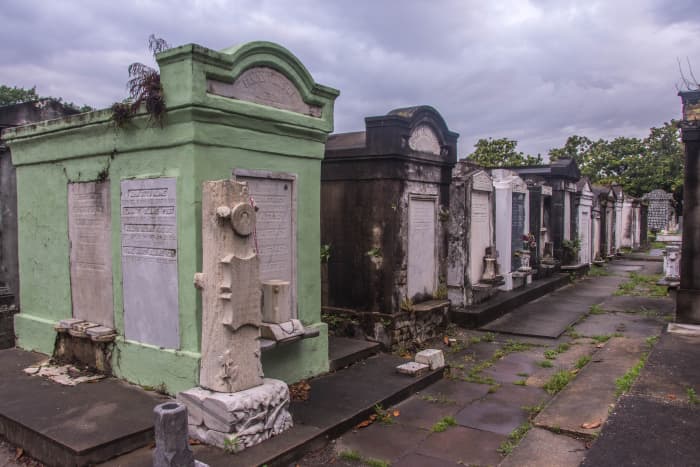The Vampire Legends of New Orleans
The Big Easy
New Orleans is an eerie place. It's Gothic in one sense and dangerous in another. The city has a rich and colorful history and is the perfect place for scouting out the supernatural. New Orleans boasts a whole host of vampire, cemetery, voodoo, and ghost tours, which often last as long as two hours. It is known as one of the most haunted cities in America.
I have gone on a vampire tour in the French Quarter, so I'll share with you the details. Why? Because being frightened is better when you can share the experience, release the fanciful fright of the mind, and purge the imagination of terror by terrorizing the imaginations of others. Join me on a journey to uncover the epic legends behind New Orleans' most famous vampires.
What Are the Most Famous Vampire Legends of New Orleans?
Vampire legends are an important part of New Orleans' history. Join me as I explore the following famous blood drinkers.
- Count Saint Germain and Jacques Saint Germain
- John and Wayne Carter
- The Casket Girls of New Orleans
1. The Count Saint Germain and Jacques Saint Germain
Count Saint Germain
Vampire stories stretch back to France in the illustrious 1700s when there was a mysterious man who charmed the courts of Europe. The Comte de Saint Germain was a very strange, extraordinary, and enigmatic character. He was a master of the piano and the violin, could converse in six different languages, and his skills as a conversationalist were unrivaled (a skill that is, nowadays, a lost art). He also composed music, including arias and solo work for the violin.
His wealth was unfathomable: He carried gems around in his clothing, and no one knew how he came into such wealth. No one knew anything about his family, where he came from, or who he was. He did, according to some accounts, claim to be a son of Francis II Rakoczi, Prince of Transylvania.
One of his greatest passions was alchemy, and he was believed to have an extraordinary talent for maintaining his youth. Perhaps it was his vast knowledge of cosmetics and herbs that kept him young. The philosopher Voltaire called him "the man who knows everything and who never dies." No one really knew his true age. He looked about 40 in all of his portraits and continued to appear so for over half a century.
Although he was charming, engaging, and graced the dinner tables of many dukes and kings, no one had ever seen him eat anything. He would only sip his wine, exquisitely, and ramble on about everything from history to chemistry.
There was much speculation about the Count’s lineage and immense wealth, which resulted in the development of many myths and legends about his background. He is considered by some to have mastered immortality, as many have claimed to have seen him since his death in 1784.
Jacques Saint Germain
Fast forward to New Orleans, Louisiana, and there appears a man by the name of Jacques Saint Germain in the early 20th century. He fits every description of the Comte above: Around 40 years of age with heavy money bags, the most fascinating of dinner guests, and still a complete mystery.
He would throw lavish parties and invite the elite, and everyone would sit enraptured in the conversation and food. But, curiously enough, this Jacques would never eat a morsel—only sip his wine.
One night, several months after moving to New Orleans, he had a lady stay a bit late. Out on his balcony (at the corner of Ursuline and Royal Streets), this Saint Germain grabbed her and tried to bite her neck. She escaped by falling from the balcony and then reported the incident to the police.
When the police came to investigate, Jacques Saint Germain had vanished. They searched his apartment and found tablecloths with large splotches of blood on them. They searched the kitchen, where they found no sign of food or evidence that food had ever been there. All they found were bottles of wine, and, after pouring themselves a glass, drinking it, and then spitting it out, they discovered that it was not only wine in those bottles—it was wine mixed with human blood.
It is unclear whether the Count Saint Germain and Jacques are the same person, but believers speculate that they are. To this day, the mysterious figure of the Count Saint Germain has his own occult following, from theosophists to complete way-out-there mystics.
Recommended
Although he allegedly died in the year 1784, no one saw his death, and some claim to have seen him many years afterward. Nevertheless, he disappeared from court life. (I would, too, if I knew that the French Revolution was coming, which some people claim he had foreseen.)

Anne Rice, famous author of vampire fiction novels such as "Interview With the Vampire," often places her characters in creepy New Orleans locations, such as Lafayette Cemetery No. 1 (pictured above).
2. John and Wayne Carter
In terms of murder rates, New Orleans ranks among the highest. It has always been a notorious place for missing persons—that is, it is a place where people just disappear, and no one ever knows what happened to them. The blood of the French, Spanish, Indian, African, Creole, and English all mix together here, where the mosquito is not so picky. Nor, perhaps, are other creatures.
John and Wayne Carter were brothers. They seemed to be normal in every aspect—they both had normal labor jobs down by the river and lived in the French Quarter. It was the 1930s during the Great Depression, and times were hard, so a man worked all he could.
One day, a girl was reported to have escaped from the Carter brothers' apartment and run to the authorities. Her wrists were cut—not enough to cause immediate death, but enough to cause her blood to drain slowly over the next several days. The policemen ran to the Carters' third-story apartment and found four other people tied to chairs with their wrists sliced in the same fashion. Some had been there for many days.
The story was that the brothers had abducted these people in order to drink their blood at the end of every day when they came home from work. Police also found about 14 dead bodies. The cops waited for the brothers to return, and when they did, it took 7 or 8 of them to hold down the two average-sized men.
A few years later, when the Carters were finally executed, their bodies were placed in a New Orleans vault. Cemeteries in New Orleans are quite picturesque—not only are they more ornate than the rest of the nation's, but they inter many generations of one family inside one vault. The remains sift down into the bottom of the vault, and when it is all rubble, a new body is slid inside.
Many years after the Carter brothers' death, when they were placing another Carter in the family vault, they discovered the vault was completely empty—no John or Wayne. They were gone.
To this day, many sightings have occurred in the French Quarter that match the descriptions of these two brothers almost exactly. Years later, an owner of their apartment saw two figures that matched their descriptions outside on the balcony, whispering to each other. Both figures jumped off the top of the third-story balcony and took off running.
The legend goes that if a vampire drinks your blood seven nights in a row, then and only then can you become a vampire. Some of those found in the Carter brothers' apartment had been there for more than seven days. One warped fellow named Felipe went on to become a notorious serial killer. And, of course, he would do more than just kill his victims; he was believed to drink the blood of all 32 of his victims.
3. The Casket Girls of New Orleans
During the colonization of New Orleans, France was having a hard time convincing women to make the voyage. This was mostly due to the fact that the men originally sent were thieves, murderers, and culprits of every type and cast (not to mention Louisiana's snakes, alligators, mosquitoes, and humidity).
Eventually, some women were sent. Some sources say they were nuns, while others say they were prostitutes, but nevertheless, a few of them made it. Many of them snuck off the ship in Mobile, Alabama, when they ported there and were told what type of riffraff they would be tricked into marrying if they stayed on board.
Historically, these women were referred to as “casquette girls,” in reference to the small chests in which they carried their clothing in other belongings.




